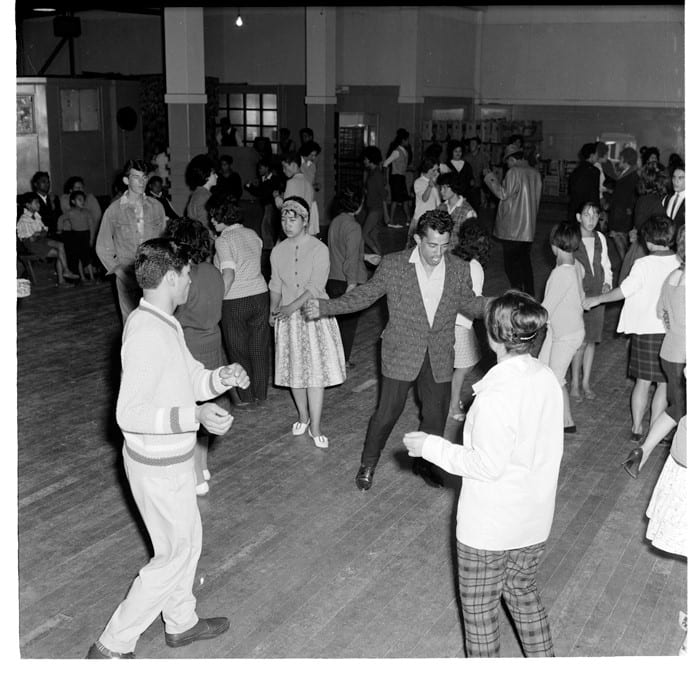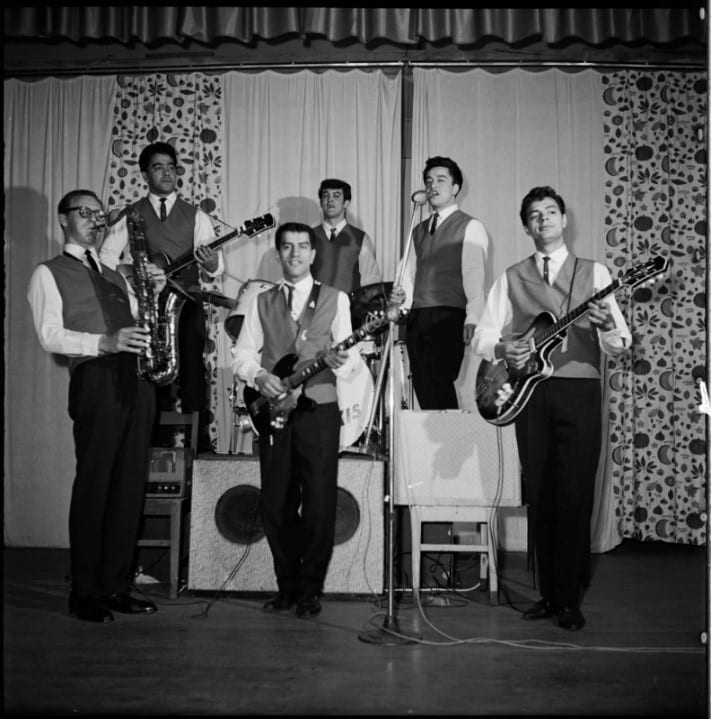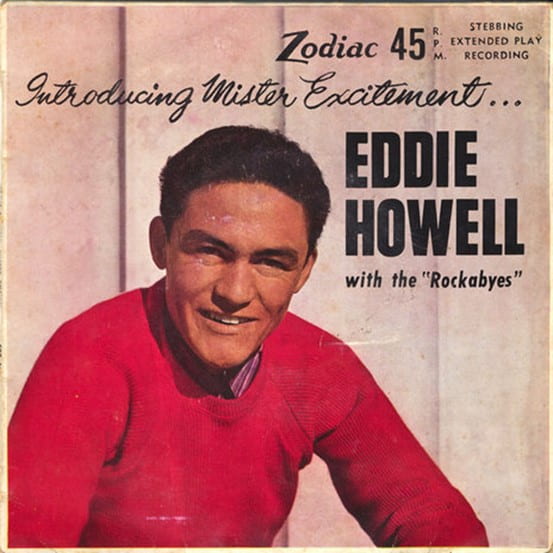Part Two
Māori Bards in the Community Centre
Part Three
Resilience
by Nicolas Jones*
Throughout the 1950s and 1960s, the Māori Community Centre was at the heart of popular culture and nightlife leisure amongst Māori living in Auckland. Whether it was because of factors such as State encouragement in the wake of the Hunn Report (1961), economic opportunities, or the appeal of adventure in the city, Auckland’s Māori population grew at a remarkably fast rate in the post-war period. As the Māori urban population increased, so too did the need for a cultural and social venue in which Māori could socialize and connect with each other.[1] This need, combined with the support by the Department of Māori Affairs, who hoped to distract urban Māori youth from “unsavoury pastimes,” contributed to the establishment of the Auckland Maori Community Centre in 1947.[2]

Dancing at the Auckland Maori Community Centre. Ans Westra, “Scenes taken at the Auckland Maori Community Centre dance,” 1962, cellulose acetate roll film, Wellington, https://digitalnz.org/records/35826979/scenes-taken-at-the-auckland-maori-community-centre-dance
Being a pan-tribal space, the Community Centre drew many Māori to its doors. In particular, the Centre was acclaimed for its social functions. Indeed, the 1950s and 1960s can be said to be the heyday of night-time activities at the Centre. Located in the middle of the inner city on the corner of Fanshawe and Halsey Street in Freemans Bay, the Auckland Maori Community Centre was ideally positioned to serve as a hub of nightlife leisure culture. As anthropologist Joan Metge attested to, the central city was highly valued by Māori because of its centrality and its short walking distance to centres of entertainment, most notably, the Maori Community Centre.[3]

The Quin Tikis performing at the Maori Community Centre. John Rykenburg, “The Quin Tikis at the Maori Community Centre,” 22 September 1961, film negative, Sir George Grey Special Collections, Auckland City Libraries, 1269-L591-5.
The popularity of the Maori Community Centre, in part, owed to its patronage and development of a musical nightlife subculture. The venue proved itself to be such a popular weekend venue that it was not possible to privately hire the Centre on weekend evenings.[4] While the Centre had seating for 400 persons, during the late 1950s and 60s, it was not uncommon for 500 people to attend the centre on Friday nights to enjoy the music of Māori musicians.[5] While the Centre was thought to be at maximum capacity at 500 persons, it was not unusual for more than that to pack the Centre for the weekly Sunday night Talent quest.[6] For example, the final of the £800 Monster Talent Quest in 1962 drew a crowd of 1000.[7]

The Kini Quartet: Martin Kini, Joe Williams, Esther Taihuka and Barney Taihuka. Redmer Yska, “The Kini Quartet Profile,” Audio Culture: A noisy library of New Zealand Music. Accessed 26 January 2019, https://www.audioculture.co.nz/people/the-kini-quartet
The Centre was not simply a concert and weekend dance venue, but rather, as historian Chris Bourke observed, it proved itself to be a “crucial venue for a generation of Maori musicians. It was their turangawaewae, the home to a musical subculture with links to every genre of popular music”.[8] As Māori urban migration increased, so too did it bring with it a variety of musicians. For these musicians, the stage in the Maori Community Centre was pivotal in establishing and developing a public following. Amongst the most successful musicians to play within the Community Centre was the Quin Tikis (pictured above). While the line-up for the Quin Tikis changed tover time, notable members included: Dora Amohau, Richard ‘Weasel’ Tairoa, Garry Wallace, Anzac Teeoka, Tab Painga and Rim D. Paul (the latter hailing from Rotorua).[9] Formed in 1961, the Quin Tikis were well known for their “uniquely New Zealand rock and roll song”, the 1963 song ‘Poi Poi Twist’ (written by Jay Epae).[10]

Eddie Howell’s 1959 EP on Zodiac. Adam Gifford, “Eddie Howell Profile,” Audio Culture: A noisy library of New Zealand Music. Accessed 28 January 2019, https://www.audioculture.co.nz/people/eddie-howell
Similarly, the Kini Quartet relocated to Auckland in 1962. Originally hailing from Gisborne, the group often performed at the Maori Community Centre and were soon signed with Zodiac records with their debut single ‘Hard Times Are Comin‘ (written by Gisborne country singer Margaret Raggett).[11] The group faded after 1974. In the case of Whakatāne born Eddie Howell, Howell’s ambition to be a singer lead him to relocate to Auckland. Eddie came to perform regularly at the Maori Community Centre between 1959-1961, proving himself to be immensely popular with a wide audience.[12] Performing such songs as ‘I’m A Man’ and ‘Trouble in Paradise’, Eddie was noted for his range of musical talent, tackling everything from ballads to rock tunes.[13] For these Māori musicians amongst others, the Maori Community Centre was not simply a music venue. Rather, the Centre signified the birth of their public music careers.
*Kia ora, I whakapapa to Tuhoe and Nga Puhi.
Nicholas completed his undergraduate studies at the University of Auckland with a major in History and a minor in Art History, graduating in 2018. He went on to complete Honours in History, graduating with first class honours and in 2020 begun a Masters in Asian Studies at the University of Auckland. His project was focused upon fleshing out the social history of Auckland’s Maori Community Centre.
[1] Richard S. Hill, “Maori urban migration and the assertion of indigeneity in Aotearoa/New Zealand, 1945–1975,” Interventions 14, no. 2 (2012): 259.
[2] Melissa Matutina Williams, Panguru and the city: Kāinga tahi, kāinga rua: An urban migration history (Bridget Williams Books, 2015), 97.
[3] ibid, 103; Joan Metge, A new Maori migration: Rural and urban relations in Northern New Zealand (London: Athlone Press, 1964), 142.
[4] Metge, A new Maori migration, 228
[5] Chris Bourke, Blue smoke: The lost dawn of New Zealand popular music 1918-1964 (Auckland University Press, 2013), 255.
[6] Jenny Carlyon and Diana Morrow, Urban Village: The Story of Ponsonby, Freemans Bay and St Mary’s Bay (Random House, 2008), 254.
[7] Bourke, Blue smoke, 255
[8] ibid, 251
[9] Bourke, “Rim D. Paul and The Quin Tikis Profile: aka The Quin Tikis, The Quintiki Showband,” Audio Culture: A noisy library of New Zealand Music. Accessed 26/01/2019, https://www.audioculture.co.nz/people/rim-d-paul-and-the-quin-tikis; “Quin Tikis musician dies,” New Zealand Herald, October 8th, 2004, https://www.nzherald.co.nz/nz/news/article.cfm?c_id=1&objectid=3598613
[10] ibid
[11] Redmer Yska, “The Kini Quartet Profile,” Audio Culture: A noisy library of New Zealand Music. Accessed 26 January 2019, https://www.audioculture.co.nz/people/the-kini-quartet
[12] Gifford, “Eddie Howell Profile.”
[13] ‘Eddie Howell’ Te Ao Hou, December 1959, http://teaohou.natlib.govt.nz/journals/teaohou/issue/Mao29TeA/c20-2.html : Gifford, “Eddie Howell Profile.”
